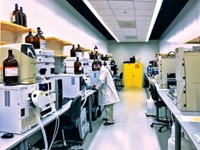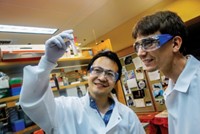Advertisement
Grab your lab coat. Let's get started
Welcome!
Welcome!
Create an account below to get 6 C&EN articles per month, receive newsletters and more - all free.
It seems this is your first time logging in online. Please enter the following information to continue.
As an ACS member you automatically get access to this site. All we need is few more details to create your reading experience.
Not you? Sign in with a different account.
Not you? Sign in with a different account.
ERROR 1
ERROR 1
ERROR 2
ERROR 2
ERROR 2
ERROR 2
ERROR 2
Password and Confirm password must match.
If you have an ACS member number, please enter it here so we can link this account to your membership. (optional)
ERROR 2
ACS values your privacy. By submitting your information, you are gaining access to C&EN and subscribing to our weekly newsletter. We use the information you provide to make your reading experience better, and we will never sell your data to third party members.
Business
Gauging Calibr
The Merck-backed nonprofit drug discovery institute is up and running, and plotting its long-term strategy
by Lisa M. Jarvis
November 4, 2013
| A version of this story appeared in
Volume 91, Issue 44

In March 2012, the California Institute for Biomedical Research (Calibr), a nonprofit devoted to translating basic science into drug candidates, launched amid much fanfare. Fueling the hype was an investment worth up to $90 million from Merck & Co. and the news that Peter G. Schultz, a renowned chemistry professor at Scripps Research Institute, La Jolla, Calif., was heading up the endeavor.
Billed as a new model in industry-academic collaboration, Calibr was to be a place where academics from across the globe could bring an idea for a medicine and see it transformed into an actual drug candidate by the institute’s interdisciplinary team. For its millions, Merck got an option to license the drug development programs after Calibr scientists had done their work.
And then radio silence. For the past year and a half, there’s been little word—no more news items and scant detail about partnerships or projects—about what’s going on inside the walls of Calibr. Meanwhile, Merck has slashed its research budget amid a major shake-up in its R&D management, moves that left open for interpretation how Calibr would fit into its new strategy.
The lack of broadcast activity might have more to do with a press-shy leader than stalled progress or waning commitment from Merck.
Schultz is starting to open up about the venture. He offered C&EN a rare glimpse inside Calibr’s well-stocked labs in La Jolla, where roughly 60 scientists are at work on dozens of projects that are starting to spawn both publications and drug candidates. And the partnering model itself is showing signs of success: In the 18 months since its launch, Calibr has teamed with big-name scientists such as Kevan M. Shokat and Lewis C. Cantley and respected organizations such as the diabetes nonprofit JDRF and the Global Alliance for TB Drug Development. Schultz hopes that by 2014 several projects will be picked up by Merck, licensed to other firms, or spun off into new companies.
Just because Calibr is up and running doesn’t mean Schultz’s work is done. The nonprofit is under pressure to show it can move novel ideas from the lab to the bedside. Merck’s commitment of $90 million over the next seven years is important support, but that money means the nonprofit is operating on a shoestring budget in the expensive world of drug discovery. The race is on for Calibr to generate revenue by producing drug candidates that are attractive enough for Merck or other parties to buy into. At the same time, the venture must broaden its financial backing to maintain stability.
Schultz views the next few years as an important test of this approach to industry-academic collaboration. “We don’t have a long-term endowment,” he acknowledges. “We really do need to be successful reasonably soon to ensure our long-term viability.”
Calibr is the brainchild of two prominent men named Peter in the drug discovery world: Schultz, a combinatorial chemistry pioneer and biotech entrepreneur, and Peter S. Kim, the former head of Merck Research Laboratories. The two scientists, who have been friends since the early 1980s, wanted to move beyond the now-common industry-academic partnership model, in which firms link with one academic investigator or one institution.
Instead, their goal was to create a way for Merck to sample the best science from around the world. To facilitate collaborations, they conceived of Calibr as a nonprofit. Merck could buy into the projects after they were far enough along so that some of the risk of failure had been removed.
Calibr is one of many experiments being conducted across the pharmaceutical industry to better access basic academic discoveries and translate them into drug candidates. These undertakings are borne of necessity. As major drug firms cut their R&D budgets in the face of waning profits, they have focused their axes on the earliest stages of R&D—research rather than development. Merck is only the latest to announce deep cuts in its R&D organization.
“When you make these sorts of cuts, you’re not going to cut the development programs because those are the ones you hope will give you short-term returns,” says John LaMattina, senior partner at the life sciences investment firm PureTech Ventures and the former head of R&D at Pfizer.
In place of in-house research, firms are looking to academia to keep their fingers on the pulse of breaking science. Meanwhile, many academic scientists are trying to get more involved in drug discovery. The efforts range from huge programs—the Vanderbilt Center for Neuroscience Drug Discovery, for example, now boasts some 100 scientists on staff—to arrangements as simple as a cluster of scientists with expertise in some aspect of the drug discovery process. Eventually, those projects feed into the pharmaceutical pipeline through the creation of biotechs or partnerships with big pharma.

It won’t be known for years which model is the most successful. But given the low flow of investment money from drug companies and venture capitalists, researchers are looking for any way to advance their early findings into marketable compounds. “I’m seeing way more outstanding science projects than I could possibly move forward,” says Jay Lichter, managing director at the venture capital firm Avalon Ventures, where he focuses on arranging deals around early-stage research.
Schultz sees Calibr as different from most academic drug discovery ventures. Whereas principal investigators at other centers tend to focus on their own projects, Calibr has an institute-wide portfolio derived from both internal and external ideas. The model, he says, means only the best ideas are pursued. “They’re all competing against each other,” Schultz says, and the decision to stop a drug discovery program or continue to invest in it is made with everyone’s input.
Meanwhile, Calibr departs from the traditional industry-academic script by forming relationships independently of Merck. In most industry-academic efforts, the drug company is at the hub of its partnerships, intimately guiding and even working with investigators. But Calibr is at the center of its academic network, with Merck acting more as a bystander. It steps in only when drug discovery projects are at the proof-of-concept stage, meaning a compound has been identified and its activity has been demonstrated.
Still, although Merck doesn’t dictate what projects Calibr can pursue, Schultz is mindful of the firm’s interests. And Merck has in some instances made an introduction or pointed out interesting science in a specific lab, says James M. Schaeffer, executive director of licensing and external research at Merck.
At the same time, having Merck aboard means drug discovery projects that have matured to proof of concept have a possible business partner. Schaeffer notes that Schultz meets with the biology leaders at Merck to tap into their expertise about how to proceed with promising projects. Unless they are part of another pact, lead candidates nearing clinical studies will first be offered to Merck.
One rationale for the structure is the belief that academic and nonprofit scientists have an easier time working with one another than with industry, where negotiations over the value of discoveries can stymie partnerships. Schultz points to one scientist who had tried for nine months to sign an agreement with a company. He had a deal with Calibr within two months of initial talks. To make things simple, Calibr and its partners equally share the proceeds from the sale of a discovery, regardless of whether it is licensed by Merck, spun off into a company, or taken on by another entity.
Calibr partners include academic scientists who have approached the nonprofit with a good idea—a promising drug target, for example—or who have been approached by Calibr about working together. Calibr and its partner pay for their respective portions of the research and discoveries are equally owned. Another spin is that nonprofits such as JDRF are paying Calibr to work with their established network of academic partners to translate their discoveries into drugs.
Calibr partner Shokat, a molecular pharmacology professor at the University of California, San Francisco, is a powerhouse in the protein kinase world. The founder of multiple companies, Shokat says Calibr provides access to technical capabilities that are hard for academics to come by.
In Shokat’s case, Calibr is using its high-throughput screening expertise—equipment and know-how that is scarce in academia—to search for compounds that are effective against a cancer target that “everybody knows but nobody thinks is druggable,” he says. “I could never take a project like the ones we’re doing with Pete to anybody at pharma because in any room of 10 people, at least half of them would say it’s impossible.”
Shokat, who is also a member of Calibr’s scientific advisory board, is part of a network of partners that few scientists could assemble. Schultz, in addition to his lengthy career in academia, has been involved in the formation of eight biotech firms. He also started, and directed for more than a decade, the Genomics Institute of the Novartis Research Foundation, a drug discovery center with more than 500 scientists.
Those connections are crucial for Calibr’s success. “Not all academics have the experience or access to capital or technology that Pete has,” Avalon’s Lichter says, noting that Schultz’s network of contacts is important both for establishing partners and for finding homes for drug discovery programs that Merck doesn’t want to adopt.
Calibr At A Glance
◾ Launched: March 2012
◾ Headquarters: La Jolla, Calif.
◾ Director: Peter G. Schultz
◾ Staff: about 60 scientists
◾ Funding from Merck: $90 million over seven years
◾ Projects under way: more than 60
Capabilities: High-throughput screening, high-content screening, medicinal chemistry, protein chemistry, and pharmacology
Modalities pursued: Small molecules, antibodies, antibody-drug conjugates, drug-drug conjugates, bispecific antibodies, protein conjugates, and vaccines
Therapeutic focus: Autoimmune and inflammatory diseases, cardiovascular and metabolic diseases, cancer cell biology, regenerative medicine, neglected diseases, and neurobiology
Partnerships with: Academia Sinica, Families of Spinal Muscular Atrophy, Global Alliance for TB Drug Development, JDRF, Lustgarten Foundation, Merck, Scripps Research Institute California, and the University of California, San Diego
Partners have an abiding trust in Schultz that allows formalities to be quickly dispatched to focus on the science. As a result, Calibr’s transformation from an idea into a fully operational drug discovery engine has been fast. Since its March 2012 launch, the institute has moved into new labs in La Jolla, with room for up to 120 scientists. The quarters boast all the capabilities necessary to turn an idea into a drug candidate, including high-throughput screening, medicinal chemistry, pharmacology, cell biology, fermentation, and a vivarium.
The 60 scientists Schultz has hired are working on more than 60 research projects. The staff includes three levels of scientists. Principal investigators “tend to be pretty young, but each person has scientific or technical expertise that collectively gives us the ability to work opportunistically on many fronts,” Schultz says.
A group of permanent staffers, meanwhile, provides drug discovery acumen that is not typically found at a university, such as expertise in compound screening, cheminformatics, and pharmacology.
The third group, nearly half the staff, consists of postdoctoral researchers with an interest in learning how to do translational research.
And just as many of Calibr’s partners have connections to Schultz; many of the in-house investigators have worked with him in the past, either at the Novartis institute or at Scripps during their training.
The Calibr team’s key asset, partners say, is its ability to conduct carefully considered screens of drug targets against the institute’s compound library. That expertise is part of what prompted JDRF to form a partnership with Calibr in March. Under the pact, Calibr is teamed with JDRF-supported academic investigators to find drug candidates with the potential to help insulin-producing beta cells survive.
“The challenge is that some of these require fairly sophisticated assays to be developed,” says Patricia Kilian, director of JDRF’s regeneration program. Developing assays and running screens “is actually a science and an art that requires a lot of expertise, and Calibr was really able to use their resources to put those in place very quickly.”
Creative thinking around how to test Calibr’s compound library has already led to success in several disease areas. To find novel compounds that could combat tuberculosis, Feng Wang, one of the principal investigators who joined Calibr from Scripps, came up with a way to screen for compounds that prevent the formation of biofilms, the slimy matrix under which bacteria assemble and thrive.
After screening 70,000 compounds—a relatively small number in the tuberculosis field—the scientists already have a drug lead. Dubbed TCA1, the compound blocks two enzymes, one involved in the survival of replicating bacteria and the other in the survival of nonreplicating bacteria. The effect was confirmed both in a petri dish and in mice, Wang says, adding that medicinal chemistry work has since led to an improved molecule.
Advertisement
TB Alliance is supporting the early development of analogs of TCA1, but the alliance’s goal is to find a drug company to undertake clinical studies when a drug candidate is chosen.
Several other projects, such as an effort to combine an immunosuppressant with a myelin repair agent to treat multiple sclerosis, are also nearing the point where a partner with bigger coffers will be needed.
Moving such programs to the next stage of development will be among Calibr’s upcoming big tests. By the first quarter of 2014, Schultz expects Calibr’s pipeline will include roughly 15 compounds that have been tested in animals. He is excited about many of them but also acknowledges that the breadth of compounds means the nonprofit will have to look beyond Merck to develop them all.
“My problem is the way I do science is the same kind of way I eat a Thanksgiving dinner,” Schultz says. “I just put so much stuff on my plate because it looks so good.”
Thus another important step for Schultz will be “beginning to diversify the funding base of Calibr such that we begin to ensure longevity and have an impact over 50 years versus five years,” he says. The nonprofit already receives support from several patient advocacy groups and is actively seeking another broad partnership like the one it forged with Merck.
At the same time, Calibr is mindful of its commitment to Merck and is starting to present the drug company with proof-of-concept data from several programs. “There are going to be a lot of projects that spin out—a lot more than we expected,” Merck’s Schaeffer says.
For Merck, even licensing a handful of projects would count as a success. A year after Calibr’s launch, amid several high-profile drug development setbacks, Kim was fired and replaced by former Amgen R&D chief Roger Perlmutter. Although Kim had personally championed Calibr, the firm says its commitment has not waned since the change in leadership and a subsequent overhaul in its R&D strategy.
As Schultz ponders the future of Calibr, he knows the pressure is on to not just conduct good science, but to have an impact on human health. “When you’re doing basic research, if you do a beautiful experiment and you write a beautiful paper, it’s a success,” Schultz says. “Here, if you do a beautiful experiment, and you write a beautiful paper, but you don’t get a drug into people, and ultimately an approved drug, it’s not a success.”





Join the conversation
Contact the reporter
Submit a Letter to the Editor for publication
Engage with us on Twitter